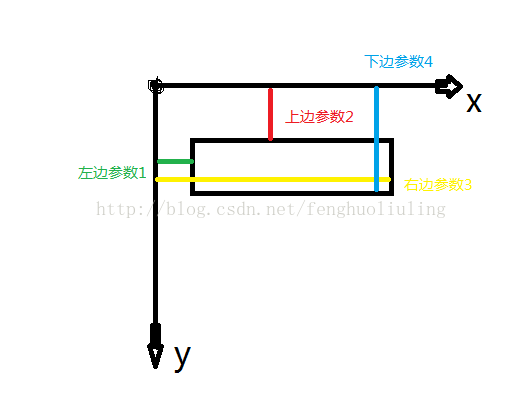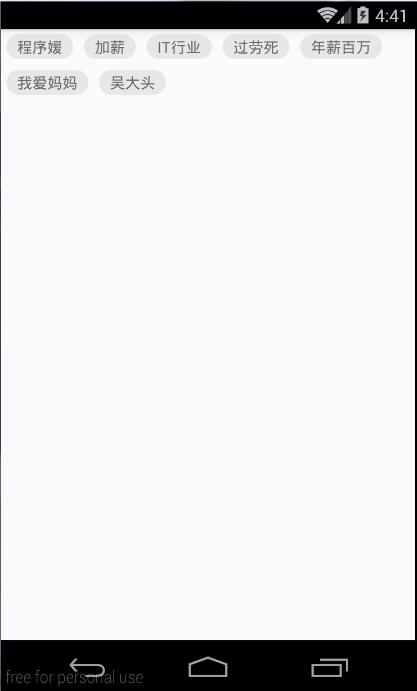Android 自定义viewGroup学习之FlowLayout的实现
最近在学习自定义的viewGroup,刚接触,是真的难,看了洪洋大神的博客,收益多多,现在记录一下我对洪洋大神这篇文章Android 自定义ViewGroup 实战篇 -> 实现FlowLayout的理解。
首先,viewGroup存在的目的是对其子view的管理,为其子view添加显示、响应的规则。因此,自定义的viewGroup需要重写onMeasure()方法来对子view进行测量,重写onLayout()方法来确定子view的位置,重写onTouchEvent()来添加响应事件。
所以,自定义viewGroup大致有以下步骤:
1、重写onMeasure()来对子view进行测量
2、重写onLayout()方法来确定子view的位置
3、必要时重写onTouchEvent()来添加响应事件。
一、创建一个类继承ViewGroup
实现它的三个构造方法:
public FlowLayoutTrain(Context context) {
this(context,null);
}
public FlowLayoutTrain(Context context, AttributeSet attrs) {
this(context, attrs,0);
}
public FlowLayoutTrain(Context context, AttributeSet attrs, int defStyleAttr) {
super(context, attrs, defStyleAttr);
}其中有一个参数的构造方法,还有两个、三个参数的构造方法,让一个参数的构造方法去调用两个参数的构造方法,让两个参数的构造方法去调用三个参数的构造方法,这样无论使用哪个构造方法产生的实例,最终调用的代码都是一致的。
二:重写onMeasure()方法
@Override
protected void onMeasure(int widthMeasureSpec, int heightMeasureSpec) {
super.onMeasure(widthMeasureSpec, heightMeasureSpec);
// 获得它的父容器为它设置的测量模式和大小
int sizeWidth = MeasureSpec.getSize(widthMeasureSpec);
int sizeHeight = MeasureSpec.getSize(heightMeasureSpec);
int modeWidth = MeasureSpec.getMode(widthMeasureSpec);
int modeHeight = MeasureSpec.getMode(heightMeasureSpec);
Log.e("TAG", sizeWidth + "," + sizeHeight);
// 如果是warp_content情况下,记录宽和高
int width = 0;
int height = 0;
/**
* 记录每一行的宽度,width不断取最大宽度
*/
int lineWidth = 0;
/**
* 每一行的高度,累加至height
*/
int lineHeight = 0;
int cCount = getChildCount();
// 遍历每个子元素
for (int i = 0; i < cCount; i++)
{
View child = getChildAt(i);
// 测量每一个child的宽和高
measureChild(child, widthMeasureSpec, heightMeasureSpec);
// 得到child的lp
MarginLayoutParams lp = (MarginLayoutParams) child
.getLayoutParams();
// 当前子空间实际占据的宽度
int childWidth = child.getMeasuredWidth() + lp.leftMargin
+ lp.rightMargin;
// 当前子空间实际占据的高度
int childHeight = child.getMeasuredHeight() + lp.topMargin
+ lp.bottomMargin;
/**
* 如果加入当前child,则超出最大宽度,则的到目前最大宽度给width,类加height 然后开启新行
*/
if (lineWidth + childWidth > sizeWidth)
{
width = Math.max(lineWidth, childWidth);// 取最大的
lineWidth = childWidth; // 重新开启新行,开始记录
// 叠加当前高度,
height += lineHeight;
// 开启记录下一行的高度
lineHeight = childHeight;
} else
// 否则累加值lineWidth,lineHeight取最大高度
{
lineWidth += childWidth;
lineHeight = Math.max(lineHeight, childHeight);
}
// 如果是最后一个,则将当前记录的最大宽度和当前lineWidth做比较
if (i == cCount - 1)
{
width = Math.max(width, lineWidth);
height += lineHeight;
}
}
setMeasuredDimension((modeWidth == MeasureSpec.EXACTLY) ? sizeWidth
: width, (modeHeight == MeasureSpec.EXACTLY) ? sizeHeight
: height);
}洪洋大神已经注释的很清楚了,真是好有爱的大神。
int sizeWidth = MeasureSpec.getSize(widthMeasureSpec);
int sizeHeight = MeasureSpec.getSize(heightMeasureSpec);
int modeWidth = MeasureSpec.getMode(widthMeasureSpec);
int modeHeight = MeasureSpec.getMode(heightMeasureSpec); 这四行代码获得它的父容器为它设置的测量模式和大小,如果是viewGroup设置为match_parent或者说模式为MeasureSpec.EXACTLY时直接使用sizeWidth和sizeHeight,即父ViewGroup传入的宽和高。反之,就要根据所有childView的测量得出的宽和高得到该ViewGroup如果设置为wrap_content时的宽和高。
这就有了最后的一句代码:
setMeasuredDimension((modeWidth == MeasureSpec.EXACTLY) ? sizeWidth : width, (modeHeight == MeasureSpec.EXACTLY) ? sizeHeight : height);这里说一下ViewGroup的layoutParams
这里重写了方法:
@Override
public LayoutParams generateLayoutParams(AttributeSet attrs) {
return new MarginLayoutParams(getContext(),attrs);
}指定了ViewGroup的layoutParams为MaginLayoutParams,那么,所有的子view.getLayoutParmas()得到的layoutParams就是子view所在父布局的layoutparams,在这里就是MarginLayoutParams。
再看看子view的宽度和高度:
// 当前子空间实际占据的宽度
int childWidth = child.getMeasuredWidth() + lp.leftMargin + lp.rightMargin;
// 当前子空间实际占据的高度
int childHeight = child.getMeasuredHeight() + lp.topMargin + lp.bottomMargin; 
是不是一目了然呢。(图片是childview.getMeasureWidth哈,写差了Width)
而事实上也是如此的,我从控制台打印出子View的left,top,right,bottom
Log.e("TAG", child + " , l = " + lc + " , t = " + tc + " , r ="
+ rc + " , b = " + bc);

第一个子view的left=10,第二个子view的left=第一个子view的childWidth+第二个子view的leftMargin,也就是134+10+10=154,
验证对了,其他同理。对这些边距,上下左右都明白了,看起来就不吃力了。
还有这个:
if (lineWidth + childWidth > sizeWidth)
{
width = Math.max(lineWidth, width);// 取最大的
lineWidth = childWidth; // 重新开启新行,开始记录
// 叠加当前高度,
height += lineHeight;
// 开启记录下一行的高度
lineHeight = childHeight;
} else
// 否则累加值lineWidth,lineHeight取最大高度
{
lineWidth += childWidth;
lineHeight = Math.max(lineHeight, childHeight);
}
// 如果是最后一个,则将当前记录的最大宽度和当前lineWidth做比较
if (i == cCount - 1)
{
width = Math.max(width, lineWidth);
height += lineHeight;
}
特别注意要加上最后一个if条件语句。当不换行时,lineWidth随着子view的增加不断变大( lineWidth += childWidth;),当lineWidth再加上一个childWidth时超过了sizeWidth(lineWidth + childWidth > sizeWidth)时就要换行,这时就将叠加当前的高度,重新开启一行,那么,如果达不到换行的要求,是不是本行的高度就没有叠加进去了呢?所以,无论怎样,到达最后一个控件都要再叠加一次高度把最后一行的高度加进去。
三:重写onLayout()方法
onlayout()方法就是要确定子view的位置,何时换行等等
/**
* 存储所有的View,按行记录
*/
private List<List<View>> mAllViews = new ArrayList<List<View>>();
/**
* 记录每一行的最大高度
*/
private List<Integer> mLineHeight = new ArrayList<Integer>();
@Override
protected void onLayout(boolean changed, int l, int t, int r, int b)
{
mAllViews.clear();
mLineHeight.clear();
int width = getWidth();
int lineWidth = 0;
int lineHeight = 0;
// 存储每一行所有的childView
List<View> lineViews = new ArrayList<View>();
int cCount = getChildCount();
// 遍历所有的孩子
for (int i = 0; i < cCount; i++)
{
View child = getChildAt(i);
MarginLayoutParams lp = (MarginLayoutParams) child
.getLayoutParams();
int childWidth = child.getMeasuredWidth();
int childHeight = child.getMeasuredHeight();
// 如果已经需要换行
if (childWidth + lp.leftMargin + lp.rightMargin + lineWidth > width)
{
// 记录这一行所有的View以及最大高度
mLineHeight.add(lineHeight);
// 将当前行的childView保存,然后开启新的ArrayList保存下一行的childView
mAllViews.add(lineViews);
lineWidth = 0;// 重置行宽
lineViews = new ArrayList<View>();
}
/**
* 如果不需要换行,则累加
*/
lineWidth += childWidth + lp.leftMargin + lp.rightMargin;
lineHeight = Math.max(lineHeight, childHeight + lp.topMargin
+ lp.bottomMargin);
lineViews.add(child);
}
// 记录最后一行
mLineHeight.add(lineHeight);
mAllViews.add(lineViews);
int left = 0;
int top = 0;
// 得到总行数
int lineNums = mAllViews.size();
for (int i = 0; i < lineNums; i++)
{
// 每一行的所有的views
lineViews = mAllViews.get(i);
// 当前行的最大高度
lineHeight = mLineHeight.get(i);
Log.e(TAG, "第" + i + "行 :" + lineViews.size() + " , " + lineViews);
Log.e(TAG, "第" + i + "行, :" + lineHeight);
// 遍历当前行所有的View
for (int j = 0; j < lineViews.size(); j++)
{
View child = lineViews.get(j);
if (child.getVisibility() == View.GONE)
{
continue;
}
MarginLayoutParams lp = (MarginLayoutParams) child
.getLayoutParams();
//计算childView的left,top,right,bottom
int lc = left + lp.leftMargin;
int tc = top + lp.topMargin;
int rc =lc + child.getMeasuredWidth();
int bc = tc + child.getMeasuredHeight();
Log.e(TAG, child + " , l = " + lc + " , t = " + t + " , r ="
+ rc + " , b = " + bc);
child.layout(lc, tc, rc, bc);
left += child.getMeasuredWidth() + lp.rightMargin
+ lp.leftMargin;
}
left = 0;
top += lineHeight;
}
} 首先,看一下这个:
mAllViews.clear();
mLineHeight.clear();
这是因为在实现过程中会多次调用onLayout()这个方法,所以每次需要clear一下。
对于这个:
/**
* 存储所有的View,按行记录
*/
private List<List<View>> mAllViews = new ArrayList<List<View>>();
/**
对于List<’List<’View>>,通俗的来讲,List<>是装东西的箱子,List’<’List<>>是装箱子的箱子。
而在这里呢,List’<’View>装的是每一行的View集合,List<’List<’View>>装的是每行所有View的List集合。
计算的View的位置相信大家通过onMeasure()都能看懂了吧。
//计算childView的left,top,right,bottom
int lc = left + lp.leftMargin;
int tc = top + lp.topMargin;
int rc =lc + child.getMeasuredWidth();
int bc = tc + child.getMeasuredHeight();
Log.e(TAG, child + " , l = " + lc + " , t = " + t + " , r =" + rc + " , b = " + bc);
child.layout(lc, tc, rc, bc);
left += child.getMeasuredWidth() + lp.rightMargin + lp.leftMargin;
这一块代码就是设置子view的位置,从上面我上传的那张图可以知道,当没有换行时,子view是按从左到右排列的。这里再附上一张view的(left、top、right、bottom)的具体位置图(感谢原图作者):
接着看:
int left = 0;
int top += lineHeight; 当换行后,left归0,高度叠加一行,重新对下一行的view进行排列,就这样将所有的view排列完成。
至此,就完成了自定义viewGroup的代码,接下来测试。
四:测试
1、先在res->drawable文件夹下新建word_bg.xml,定义一些样式
<?xml version="1.0" encoding="utf-8"?>
<shape xmlns:android="http://schemas.android.com/apk/res/android">
<solid android:color="#e7e7e7"/>
<corners android:radius="30dp"/>
<padding
android:top="2dp"
android:bottom="2dp"
android:right="10dp"
android:left="10dp">
</padding>
</shape>2、再写一个word.xml
<?xml version="1.0" encoding="utf-8"?>
<TextView xmlns:android="http://schemas.android.com/apk/res/android"
android:layout_width="wrap_content"
android:layout_height="wrap_content"
android:text="HelloWorld"
android:background="@drawable/word_bg"
android:layout_margin="5dp">
</TextView>3、在主布局文件里调用
<RelativeLayout xmlns:android="http://schemas.android.com/apk/res/android"
android:layout_width="match_parent"
android:layout_height="match_parent">
<com.calolin.testdemo.FlowLayoutTrain
android:id="@+id/flowlayout"
android:layout_width="wrap_content"
android:layout_height="wrap_content">
</com.calolin.testdemo.FlowLayoutTrain>3、在mainActivity里:
public class MainActivity extends Activity {
String [] tv_datas=new String[]{
"程序媛","加薪","IT行业","过劳死","年薪百万","我爱妈妈"
,"吴大头"
};
private FlowLayoutTrain mflowlayout;
@Override
protected void onCreate(Bundle savedInstanceState) {
super.onCreate(savedInstanceState);
setContentView(R.layout.flow_layout);
mflowlayout= (FlowLayoutTrain) findViewById(R.id.flowlayout);
LayoutInflater mInflater=LayoutInflater.from(this);
for (int i=0;i<tv_datas.length;i++){
TextView tv= (TextView) mInflater.inflate(R.layout.tv,mflowlayout,false);
tv.setText(tv_datas[i]);
mflowlayout.addView(tv);
}
}
酱酱:
完了。新手,有错误的请多指教。
























 5662
5662

 被折叠的 条评论
为什么被折叠?
被折叠的 条评论
为什么被折叠?








